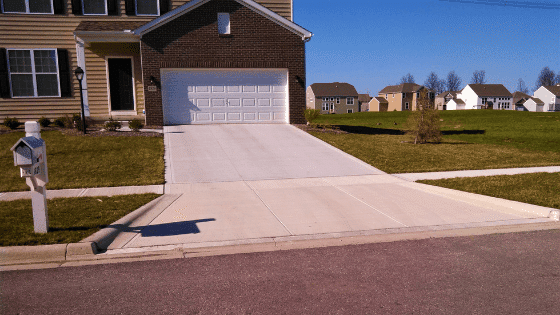Table of Contents
Last Updated on August 9, 2024 by Heenan
Once you get a new concrete driveway, it’s highly recommended that you start planning for sealing to ensure its longevity. It will increase the appearance as well as protect the driveway for long time from cracking and spalling.
While sealing the concrete driveways (concrete surfaces) is a DIY project, at the same time, doing it in the right way is vital without any doubt.
This article will describe all the nitty-gritty of sealing concrete driveways following some simple steps.
Before I begin, here are the tools you should gather to get the best results.
- Concrete driveway sealer. It has to be either a penetrating water repellent to penetrate deep into the concrete or a solvent-based or water-based sealer.
- A gas-powered sprayer. A gas-powered sprayer is more convenient than a pump-up sprayer as it gives constant pressure without needing you to stop and pump up every few seconds.
- Nap roller (Optional).
- Broom or leaf blower.
Let’s get to the steps involved in sealing the concrete driveways.
How to Seal a Concrete Driveway – 5 Dead Simple Steps
Pro Tip 1: If you plan to apply concrete sealers on a recently installed driveway, make sure you give at least one full month (30 days) to cure the surface properly.
Pro Tip 2: If you are planning to reseal the surface, remove the old sealer. Clean the driveway, let it dry then go to step 1.
Step 1
Choose the right concrete sealer based on your need and preference. You can go for either solvent sealer or water-based sealer, as both these types can penetrate the surface. Companies like Foundation Armor offer different penetrating sealers for different appearances like wet look, high gloss, low gloss, semi-gloss, etc.
Remember, don’t go cheap when choosing a concrete penetrating sealer.
First, measure the area you need to cover in square feet. Then see the coverage of the sealer (per coat per gallon). Buy the required amount of sealer, considering the area of your driveway.
Step 2
The second step is to clean the surface entirely to remove all the loose materials like debris, leaves, dirt, etc. You can dry clean the surface using a broom or a leaf blower.
Or you can pressure wash the surface to get the best result. If you use water to wash the driveway, give it at least one full day (24 hours) before applying the driveway sealer.
If you see any oil stain or grease stains on the surface, remove those. It would help if you had a pressure washer to get things done easily. Again, give it at least 24 hours before applying the concrete sealer.
If it rains between the drying hours, let the surface dry for another day after the rain stops.
Step 3
Pour the sealant into the sprayer or bucket (if you are using a roller) as much as you think is ok to carry at a time. Start with 3 gallons, and if you find it’s not too heavy for you to carry, pour another 2 or 3 gallons.
Step 4
Start applying the sealer evenly using the sprayer or roller along the driveway’s width.
The primary method of applying the sealer is the same for both gas-powered sprayers and rollers. Using a roller, do it as you do while painting a wall. Using a roller is ideal when you are applying a solvent sealer. For water-based penetrating sealers, it’s all up to you.
Remember, you should not allow the concrete sealant to build up anywhere, whether using a sprayer or roller.
Using a nap roller takes more time to complete than using a sprayer.
Step 5
Let the sealer cure before you allow any foot traffic or vehicle traffic. The curing time varies based on the sealant type. Following the company’s recommendation is better for the best results.
If you need to apply multiple coats, give it enough time to cure between the coats.
Frequently Asked Questions (FAQs)
#1. Is it necessary to seal the concrete driveway?
Sealing a driveway is an utmost necessity for multiple reasons. It’s not like the companies are trying to make money by forcing you to do something optional.
Sealing the concrete surface is necessary to protect the driveway from moisture, cracks, spalling, and discoloring. To protect the driveway from water penetration, it’s essential to seal it entirely.
Sealing ensures the longevity of the driveway. Without sealing, there is a big chance that it will fail prematurely.
It enhances the appearance too. You will find different types of concrete driveway sealers on the market. You can choose based on your preference, depending on the gloss level you want and the type of sealer (water-type sealers or solvent sealers).
Remember, don’t overdo it. You better seal concrete surfaces every four or five years to get the best results.
#2. What is the best sealer for a concrete driveway?
The most popular type of concrete sealer is made of pure acrylic resin. It would help if you bought either solvent-type sealer, water-based sealer, or penetrating water repellents, as these are made of acrylic resin.
Water sealers give a low gloss and minimal darkening, but it’s quite efficient in chemical resistance.
The solvent-type sealers are high gloss sealers that darken the concrete and enhance color development.
On the other hand, the penetrating water repellents don’t change the concrete driveway’s appearance and don’t give enough protection from oil stains. However, it can protect the concrete floors from thaw damage, deicing chemicals, etc.
The best sealer for the concrete driveway is Armor AR350 acrylic wet look sealer; the best water-based concrete sealer is the MasonryDefender concrete driveway sealer.
#3. Is it better to roll or spray a concrete sealer?
It depends on the type of sealant you are going to apply. If it’s a penetrating sealer, then preferably, you will want to use a sprayer, mainly if it’s a water-based sealer. For solvent-based ones, you might want to go for a roller.
On the other hand, if it’s an epoxy coating or acrylic resin-based sealer, the roller is the best tool for the application. Any 1/4″ or 3/8″ is ok to get the job done correctly.
If you choose to use a sprayer, you can either use a gas-powered sprayer or a pump-up sprayer. I prefer a gas-powered one to a pump-up one because of its constant pressure without needing you to pump the sprayer every few minutes.
#4. Can you seal old concrete?
Yes, you can seal an old concrete surface whether it was previously sealed or is entirely an unsealed concrete surface.
If you plan to reseal a surface, consider removing the previous seal first. After removing the previous sealer, clean the driveway and wait for dry. However, some sealants, like solvent-based acrylic sealers, aren’t required to be removed before applying a solvent-based sealer again.
Consider filling the cracks that the old surface has developed so far.
#5. When to seal a concrete driveway?
The right time to seal new concrete depends on the type of sealer being used.
If a “cure and seal” type is used, it can be applied immediately after finishing the application for added protection against everyday wear and tear.
Sealing concrete with a cure and seal is the best way to stop it from getting dirty or stained.
Suppose you’re not using a cure and seal. In that case, newly poured slabs such as patios, walkways, driveways — anything where vehicles will be driving on regularly — need to wait about 2-4 weeks before getting sealed so they can dry without being disturbed by traffic.
The industry standard is 28 days, but this varies depending on climate & mix of concrete; talk with our experts if you need help deciding when would work best in your area!
Don’t wait too long to apply your sealer. If you do, the concrete will have to be cleaned and degreased before it can be sealed again.
Another issue is if you use a clear sealer on new cement, any stains or other marks may show through, so we recommend waiting at least one month but not much longer.
#6. How to reseal a concrete driveway?
Step 1:
The concrete sealer should be applied with a roller or garden sprayer.
First, add the sealant to your tank and apply it evenly.
Try not to let any of this build up on the surface because if you get buildup, remove excess with a rag while trying not to drip anything onto surfaces that don’t need protection yet.
You’re going for an even application! Let the first coat dry before starting the next layer (or wait 24 hours).
Sealer should be applied just as you would paint a wall.
Use a large brush for the edges and seams, but roll over any rippling buildup to push excess forward when using one that has been used with pesticides to prevent build-up from being pushed back onto freshly painted surfaces.
Step 2:
Read the instructions for your concrete sealer before applying a second coat.
For good results, you may need to apply the next layer at an angle, depending on your brand of sealant.
Let it cure the following these directions, and congratulations! You’ve sealed those cracks with success in no time!
#7. How to seal cement driveway?
1) Clean your driveway. Scrub with a soap and water solution to remove dirt, and be sure you’ve removed any oil stains or other substances that may prohibit the sealant from bonding.
2) Let it dry. Dirt will compromise a sealant’s effectiveness, so ensure everything is clean before adding anything else.
3) Apply a thin layer of driveway cleaner to dingy areas or patches of surface cracking caused by winter wear and tear (primer coat). Refer to the label on the can for instructions on how much primer is needed for your area size, then apply it in a thin, even line with a roller or applicator.
Final Words
As you can see, sealing a concrete driveway is not a hard job, and it doesn’t require you to gather too many tools and accessories. It’s undoubtedly a DIYer project to me, and you don’t need to hire any professionals here, spending a lot of money.
Follow the steps correctly, and don’t go cheap when choosing the tools and sealant.
Keep in mind that sealing driveways under direct sunlight is essential to get the best results.

